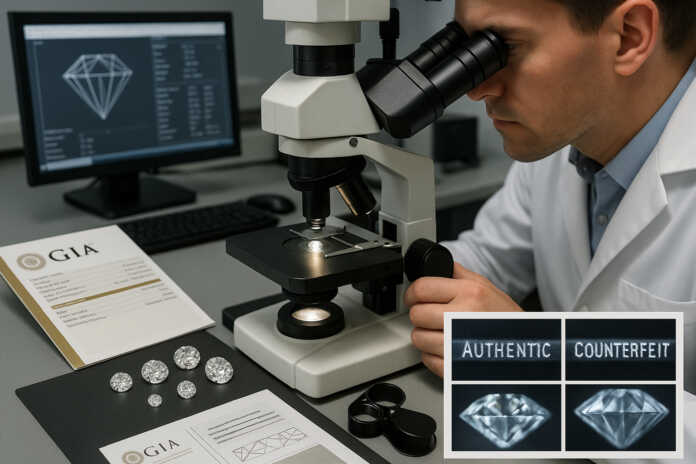In an alarming development that has sent shockwaves through the global diamond industry, the Gemological Institute of America (GIA) has uncovered a sophisticated fraud scheme involving diamonds bearing counterfeit inscriptions. This revelation, published in the institute’s quarterly journal Gems & Gemology, highlights a pressing concern for jewellers and consumers worldwide as the market continues to evolve amid rising demand for both natural and laboratory-grown diamonds.
The Dubai Discovery: A Wake-Up Call for the Industry
The fraud came to light at GIA’s Dubai laboratory when four diamonds submitted for updated services raised immediate red flags. Upon initial examination, gemologists noticed inconsistent font styles and placement of the GIA inscriptions—telltale signs that these were not authentic certifications. The discovery represents a new sophistication in diamond fraud, posing significant risks to jewellers and consumers globally.
The fraudulent stones had been carefully selected to match features listed on original reports, demonstrating the meticulous planning behind this scheme. However, subtle differences in colour grades, measurements, and other characteristics ultimately exposed the deception. Most notably, while all diamonds from the original reports were classified as type Ia, the submitted stones were type IIa—a critical discrepancy that helped unmask the fraud.
The Anatomy of Sophisticated Diamond Fraud
The case involved a complex mix of natural and synthetic diamonds, each presenting unique challenges for detection. Two of the fraudulent diamonds were natural stones that had undergone High Pressure-High Temperature (HPHT) treatment to enhance their colour. This process can dramatically alter a diamond’s appearance and value.
One particularly striking example involved a supposedly 1.07-carat, E-colour, VVS1 clarity diamond with cloud, pinpoint, and feather inclusions. The imposter stone, while maintaining the same carat weight and colour grade, had been downgraded to VS1 clarity and contained different inclusion patterns, including feather inclusions and internal graining.
The remaining two stones were laboratory-grown diamonds created through chemical vapour deposition (CVD) technology, both subjected to post-growth HPHT processing. These synthetic diamonds arrived bearing inscription numbers of natural diamonds, representing a brazen attempt to pass off manufactured stones as naturally occurring gems.
Implications for the Global Jewellery Market
This sophisticated fraud scheme arrives at a critical juncture for the global diamond industry. The global synthetic diamond market continues to expand rapidly, with laboratory-grown diamonds typically costing 30-40% less than natural stones. This significant price differential creates substantial incentives for fraud across all markets.
Consumers have increasingly adopted laboratory-grown diamonds due to their affordability and ethical sourcing benefits. However, this growing acceptance also creates opportunities for fraudsters to exploit price differences between natural and synthetic stones. When a lab-grown diamond can be passed off as natural, the profit margins for criminals become substantial, affecting jewellers and consumers in every market.
Enhanced Security Measures and Industry Response
In response to the rising threat, GIA has implemented same-day verification services to combat fraudulent inscriptions. This service allows jewellers to quickly confirm that diamonds bearing GIA inscriptions match their accompanying reports. Professional Jeweller The initiative represents a crucial step in protecting both industry professionals and consumers from increasingly sophisticated fraud attempts.
The verification process has become essential as fraudsters develop more refined techniques. Modern counterfeit inscriptions can appear convincing to the naked eye, making professional verification tools indispensable for jewellers worldwide. The GIA’s Report Check service, available online, allows anyone to verify certificates issued since January 2000, providing an additional layer of security.
Best Practices for Jewellers
To protect their businesses and customers, jewellers should implement comprehensive verification protocols. This includes utilizing GIA’s online verification services, maintaining relationships with certified gemologists, and investing in detection equipment that can identify treated and synthetic diamonds.
Jewellers should also educate their staff about the subtle differences between natural and laboratory-grown diamonds, as well as the various treatments that can alter a stone’s appearance. Regular training on the latest fraud techniques and detection methods has become essential for maintaining credibility in an increasingly complex marketplace.
The Broader Impact on Consumer Confidence
The discovery of these counterfeit inscriptions underscores the critical importance of certification authenticity in maintaining consumer confidence. Recent investigations have revealed questionable practices among some retailers globally, making third-party verification even more crucial for the industry’s integrity.
For consumers worldwide, this incident serves as a reminder to work only with reputable jewellers who can provide proper documentation and verification services. The ability to independently verify a diamond’s certification through GIA’s online services provides consumers with additional peace of mind in their purchasing decisions, regardless of their location.
Looking Forward: Strengthening Industry Standards
The GIA’s findings highlight the need for continued vigilance and enhanced security measures throughout the diamond supply chain. As fraud techniques become more sophisticated, the industry must evolve its detection and prevention capabilities accordingly. The implementation of blockchain technology for diamond tracking and advanced spectroscopic analysis for rapid identification of synthetic diamonds represents promising developments in this ongoing battle against fraud.
Jewellers who prioritize transparency, proper certification, and regular verification will be best positioned to maintain consumer trust in this evolving landscape. The cost of implementing robust verification systems pales in comparison to the potential damage from unknowingly selling misrepresented diamonds.
This incident serves as a crucial reminder that in the diamond industry, trust is the most valuable asset—and protecting it requires constant vigilance, professional expertise, and unwavering commitment to authenticity.
![]()









